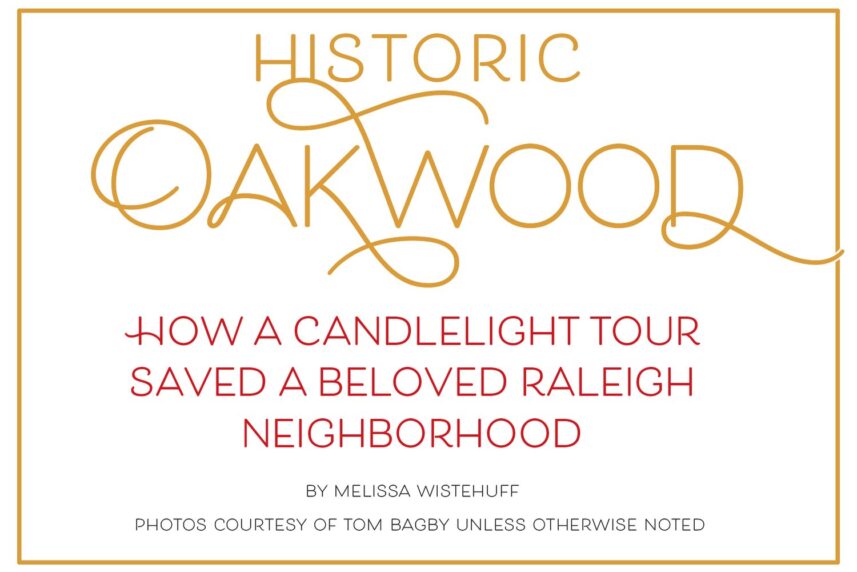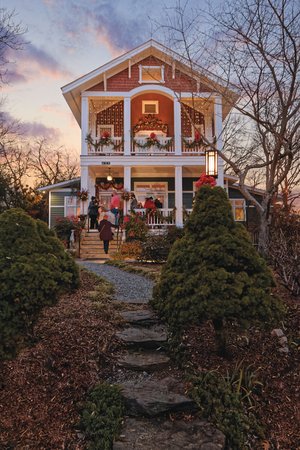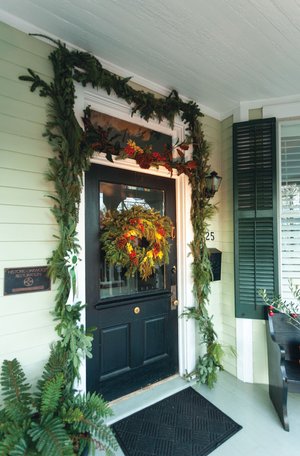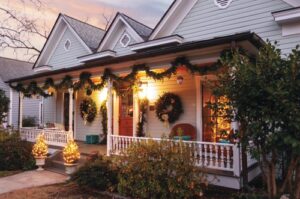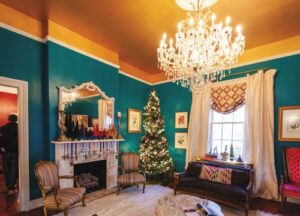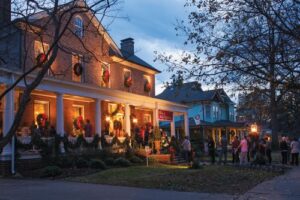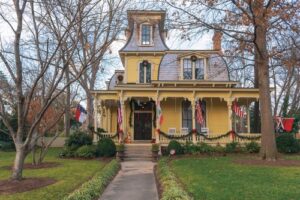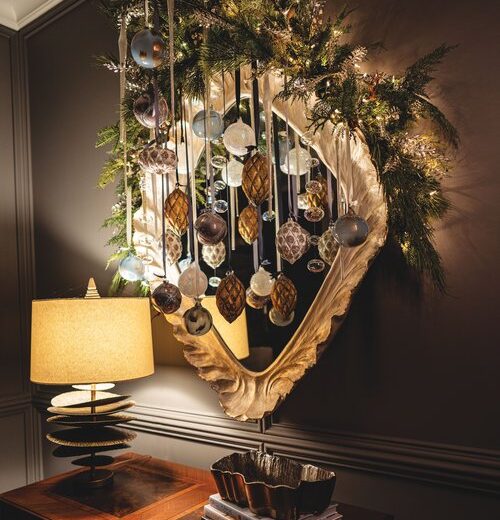Article:
Today, Oakwood is regarded as one of Raleigh’s most prestigious neighborhoods. An area steeped in rich history, Oakwood is the city’s only intact 19th‑century neighborhood—and the first to be listed in the National Register of Historic Places. Since the majority of homes were built between 1890 and 1930, they reflect a wide range of architectural styles, including bungalows, Classic Revival, Second Empire and, perhaps Oakwood’s grandest style, Queen Anne. Tree-lined sidewalks, small front yards and sprawling front porches make Oakwood one of the most walkable—and beautiful—areas in the City of Oaks.
It’s hard to imagine Raleigh without Oakwood, yet in the early 1970s, North Carolina adopted the State Capital Plan, which called for the North-South Freeway to be built through the heart of Oakwood, thus demolishing all homes in its path. At the time, Oakwood was no longer as trendy as it had previously been considered.
The emergence of automobiles allowed residents to live further outside of the city’s center, and many of Oakwood’s homes fell into extreme disrepair. The neighborhood’s homeowners, however, were desperate to save their beloved community.
The Society for the Preservation of Historic Oakwood
Short on hope and time, Oakwood residents formed the Society for the Preservation of Historic Oakwood in the early 1970s. It was incorporated on November 1, 1972. “They knew that in order to save Oakwood, everyone else in town needed to see how special it was,” says Matthew Brown, an Oakwood resident since 1986 who is also a board member and immediate past president of the Society for the Preservation of Historic Oakwood. “If they could get the rest of the community to rally with them, perhaps they could make town officials change their minds.”
The inaugural candlelight tour was held on December 17, 1972. Although only 10 homes were showcased that first year, neighbors pitched in to make the homes look as spectacular as possible. Trees, garlands, embellishments and, of course, white (electric) candles—for which the tour is named—adorned each window.
The tour was a grand success, drawing approximately 700 revelers. By welcoming the outside community into their homes, Historic Oakwood residents garnered the support they needed for Raleigh’s city council to nix the planned freeway.
Today’s Candlelight Tour
The Historic Oakwood Candlelight Tour now attracts thousands of visitors every year. Musicians stroll the streets performing Christmas carols. Carriages and rickshaws shuttle visitors between homes. Porch hosts armed with knowledge of the homes’ histories greet guests as they enter. Quite often, the homeowners themselves are inside, happy to answer visitors’ questions.
The Oakwood Garden Club awards winners for decorations in categories such as Victorian, Traditional and Southern. While each year brings variations in decorations and, occasionally, new homes or themes, Brown says the tour strives for “tradition and continuity.”
The real draw, after all, is the homes themselves—not the holiday decor. “Some homeowners take months to prepare their homes each season. Some do all the work alone, while others hire professional decorators,” Brown says. “Everyone puts their heart into it.”
Brown shares that although it’s a treat for homeowners to show off their dazzling homes, it’s also “an opportunity to share the love of historical architecture, with the hope that other towns and neighborhoods will want to preserve their history, like we have.”
Victorian neighborhoods are rare in North Carolina cities. “There are no Victorian neighborhoods remaining in Durham or Charlotte,” Brown says. “If other neighborhoods can see how we’ve come together to salvage our history and inspire others to follow suit, then it makes all our hard work even more meaningful.”
Funding Oakwood’s Future
The Historic Oakwood Candlelight Tour is the primary fundraiser each year for the Society for the Preservation of Historic Oakwood, and its proceeds go a long way toward fulfilling its primary purpose of preserving the neighborhood. Many Oakwood homes would not exist today if not for the tour revenue, as it has assisted in the restoration of some of its most dilapidated houses. The society has also built a neighborhood park, planted hundreds of trees and helped maintain homes.
With all the changes Raleigh has seen in recent decades, this group continues to diligently conserve the remarkable history of one of the city’s most cherished neighborhoods. Learn more about the society and tour at historicoakwood.org.
Photo courtesy of Kevin Lord
Photo courtesy of Steve Jah
Candlelight Tour Pro Tips
The 2022 Historic Oakwood Candlelight Tour is scheduled for December 10–11. Check-in is at the Tucker House, which is located at 418 N. Person Street.
Arrive early! Although the event is referred to as a “candlelight tour,” ticket holders can enter as early as 12:30 p.m., and the tour ends at 7 p.m. The tour takes about three hours. Take advantage of the entire time to ensure that you are able to visit all the homes.
Watch your step. The sidewalks throughout Oakwood are as old as the homes, making for uneven walkways.
Veer off course to tour the adjacent 12.7-acre Oakwood Park or Historic Oakwood Cemetery, which dates back to the Civil War.

Tell Your Story
Glenaire builds community by encouraging residents to share their life stories
Just as an aging neighborhood like Historic Oakwood has many stories to tell, so do Wake County’s elderly residents. For this reason, Glenaire, a life plan community in Cary, launched the “Tell Your Story” program, a monthly gathering during which residents share details about their lives. Created by activities director Hannah Erickson,
“Tell Your Story” offers a glimpse into who people are, what defines them and what is important to them.
Transitioning into a retirement home often comes with unforeseen challenges. Even when the logistics of a move are well-planned and thoughtful, settling in can take some getting used to.
Erickson says new residents often have a hard time making connections. “People usually move in without knowing other residents, so they essentially have to start over—make new friends, new connections and relationships—while entering into a new stage of life,” she says.
That’s why she created the “Tell Your Story” program. “Each person moves to Glenaire with a unique story. This program is a way to get them to share that story,” Erickson explains. “Sometimes it takes thought-provoking questions to get people to open up about what shaped them before they moved here. It helps create bonds and build community—not only with other residents, but with the staff as well.”
Learn more at brightspire.org/glenaire.
